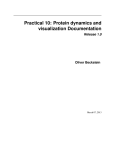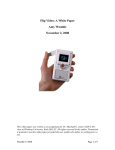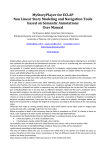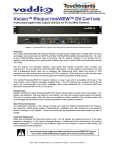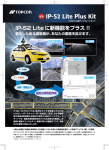Download Course project - Computer Science
Transcript
Autumn 2015 COSC 3P98 - Project Guidelines Due Dates: Animation or programming: early January 2016. Essay: early December. (Exact dates TBA.) Project topic approval: Run your idea by me if you are uncertain. Try to do so before the end of October. Groups: Animation projects can be done individually or in pairs. Programming projects can also be individual or in pairs depending on the project (please ask me first!). Both group members must contribute equally to any group project. Otherwise, grades may be assigned accordingly. Essays are done individually. Topic ideas: The topic for your project is flexible, and it is your choice to do a project that you feel is most suitable for you. Note that there is no mark advantage to choosing one topic over another. In other words, an animation project does not automatically receive a higher mark than, say, an essay. Plagiarism and use of open source code: See COSC 3P98 course outline. 1. Essay Write an essay on a graphics topic of your choice. This may be about some graphics technology topic you have discovered in the textbook or other book, a commercial application, or an advanced area of research in graphics. The best place to start is to look through computer graphics texts, conference proceedings, journals, and the web. The textbook has a bibliography you can use to track down additional sources. The library has a large collection of graphics resources. The Web has an enormous number of resources. It is important that you investigate a variety of literature in the area you have chosen. The requirements for the references are as follows: • • • • You should include at least 5 relevant references for your paper. These 5 references cannot be from web sites, but rather, from published journals, books, or conferences. You can include additional references to web sites. You need to cite all your references in the text of your paper. For example, “Perlin noise [3]...” where [3] is the 3rd numbered citation in your bibliography. Otherwise, citations that are not discussed in your text will be ignored. You should look at the various electronic databases in Brock’s library and the web, for example, Scholars Portal, Citeseer, and Computer Science Bibliographies. (The latter has a special database on computer graphics research.) Eventually, you may need to use our library's interlibrary loan facility. You may consider visiting other university libraries in the vicinity, such as those at Waterloo, McMaster, and Toronto. Evaluation: The primary criterion is that your paper clearly discusses your own ideas and criticisms in an organized way in your own words. Do not cut and paste text you Autumn 2015 find from the web or other sources into your paper. I am interested in what you have to say, and not what others have said. It is considered plagiarism if you include text which isn't attributed to its source. Turnitin.com is used on submitted essays. A written paper (8 pages minimum, 12 pt font, 1.5 line spacing, and reasonable margins) is to be submitted. The paper must be word-processed. It will be marked on grammar and spelling. The paper must have at least the following structure, with numbered section headings clearly given (additional sections are fine): • Title and abstract (paragraph) • 1. Introduction • 2. Discussion (may organize further into multiple sections) • 3. Conclusion • Bibliography Please see the web site h t t p :/ / w w w .w r i t i n g.en gr .p su .ed u / for information on writing styles, bibliography formats, etc. 2. Graphics application Here are a few suggestions for a programming project: • Game: It may use OpenGL, CG, Direct3D, or some other graphics library. It should be significantly different than the assignment questions. • Implement an application that uses pixel and vertex shading. • Plug-in: Implement a plug-in module for a graphics application, for example, Adobe Photoshop or Blender. You can download a software developer’s kit (SDK) from the Adobe web site. It contains library modules, programming interfaces, and documentation for implementing software that interfaces with their host applications. For example, an interesting plug-in might be a new Photoshop filter. It could be a unique filter of your own invention, with lots of algorithmic parameters controlled by the user interface. • Tablet or console app: Write a graphics application for a handheld or embedded device (Android, iPhone, iPad, PSP), web-based system or game console (Wii, Xbox, PS3). • Processing app: Processing is a new Java-based programming environment for graphics, animation, and media. It is freely available on the net. It can be used to generate impressive animations and multi-media presentations. • Mathematics application: Implement a computational geometry algorithm (not an assignment question!) or fractal generator. • Implement a 3D visualization app. Hand in an electronic and hard-copy of your project: compiled application, and hardcopy of all source code and data. Include a 6 to 8 page paper describing your system's functionality, architecture and implementation, user manual, references, etc. The paper Autumn 2015 may take the form of web pages that you have printed; if so, hand in the web site electronically as well. For games, make sure to describe all algorithms used, and cite sources of libraries, textures, models, sounds, etc. 3. Ray Tracer This is another programming project. The ray tracer will read in a text file (or XML) describing a scene. It will then generate an image file rendered with ray tracing. The 3P98 web site has online notes with all the necessary technical details for implementing the ray tracer. For full marks, the ray tracer should do the following: Basic: • • • • • Objects: planes, spheres, polygons (triangles) Reflection Shadows Single light Material effects: diffuse, specular, ambient Those working in groups should also implement the following for full marks. People working alone on the ray tracer can do these for extra marks: Advanced: • Another object (torus, cylinder, ...) • Refraction • Multiple lights Submit a number of examples showing of your ray tracer in use, including the text files used to define them and the resulting rendered images. Also submit a 6-8 page paper describing your system architecture, user guide, references, etc. 4. Animation Use an animation system to produce a computer animation. The department has licenses for Bryce 6 and Poser 7 (Windows). The free Blender system is very powerful. The university has a lab license for the Maya animation system (however, access to it may be restricted). A number of other tools are available, such as 2D drawing programs (Illustrator, Photoshop), video editors (Premiere), and music generation programs (Ableton Live, Adobe Audition). Some technical guidelines: 1. Use a standard video format: Quicktime, MP4, AVI, WMV, DivX... 2. Resolution: perhaps 640 by 480 or higher (depending on render time!), 24 frames/sec or more 3. Time length: at least 20 seconds 4. Soundtrack: sound effects and/or music Content: The content of your animation is up to you. You will be graded on the independent work you have done in the production (animation, models, textures). If you Autumn 2015 borrow 3D models and textures from other sources, please attribute them appropriately. If you make your own 3D models, let me know that in your hand-in, so that I can give you credit for that work in your final grade. However, please do not hand in the end result of a tutorial you have walked through for some animation system. Rather, you should use this project as an opportunity to be creative. A number of tools are available: 1. Blender: Highly recommended! This is a free, general-purpose animation system. It is very powerful, and has been used to create impressive animations. Like all commercial animation systems, it has a learning curve. A number of tutorial books on Blender are available. It also has a large user community. 2. Poser: This is a program specialized for human character animation. A Poser animation should have some interesting key framed animations of one or more human (or mutant) characters. You should have a suitable background rendered in the animation, perhaps created with Bryce. 3. Bryce: Bryce is specialized for realistic and surreal scenery. It has the ability to do basic modeling, and can import 3D models created in other programs. It also has an animation system, which will permit key framing of objects, lights, textures, as well as the camera (good for camera fly-by's). If you do a Bryce animation, you should include some models created with Bryce, such as cities, vehicles, objects, or other artificial structures. 4. Other animation systems: You are welcome to use other animation systems. Beware that systems often have steep learning curves (eg. 3D Studio Max, Maya). 5. Windows Moviemaker: This and other applications (Adobe Premiere, Sony Vegas) let you do basic video and sound editing, and export into a video file. For best results, render your animation clips as an uncompressed image files. Then load these images, as well as a soundtrack and sound FX, into Moviemaker. Export your final movie as a compressed movie in a suitable video file format, at a high quality setting. Beware of uncompressed CD-quality sound, as it can double the size of your animation file. Animation ideas: Look at the 3P98 animation gallery, as well as user galleries on the web, for examples of what can be done with Poser, Bryce, and other systems. There are some amazing examples available, and they may give you some ideas about what is possible with these systems. You are only hindered by your imagination. Documentation and hand-in: Create a web page describing all the creative and technical aspects of your animation. Be sure to attribute all sources of models, textures, and sound effects and music. Printed, the web site should be about 6 to 8 pages. Hand in the printed web page, its URL, and COSC cover page. (See the 3P98 gallery for examples). Autumn 2015 Some general advice about animations: 1. The best animations are those that have a simple idea that is done well. Try to avoid being too ambitious. 2. Making an animation is the same as producing an entire movie. You are the writer, director, set designer, artist, photographer, sound effects engineer, actor... Each of these aspects of the animation requires attention. Professional animations involve large teams of experts specializing in these areas. 3. The most technically challenging aspect of animation is timing. Make use of draft, thumbnail rendering of animations, so that you can test the timing of your animated objects and camera. For example, make sure your camera does not pan too quickly, or make sudden linear changes. Be aware that the speed of the real-time wire frame previews that you see on your monitor may not match that of the final rendered video. 4. Pay attention to lighting. Just as with film and video photography, overly bright lights can create washed-out scenes with muted colours. Weak lighting results in dark, obscured images. Shadows can occur with ray-traced environments, and they are tricky to deal with (you may want to disable shadows). 5. Make sure your models are clearly visible in the animation. If the models are too far away, or obscured by other objects, or enter and leave the scene too quickly, then the viewer will not even notice them. See note 3 above as well, because a fast camera can zoom past a model too quickly. 6. Try not to move your camera around too much. Quickly turning cameras and those that use zooms too frequently are difficult to watch. If your models are doing lots of movement, then keep camera movement to a minimum. Separate camera cuts that are spliced together are probably more effective than to move the camera itself. One kind of animation to consider is one in which the camera stays relatively still, and the objects animate in front of it. 7. Be aware of aliasing problems: a. Temporal: if objects move cyclically, make sure they don’t synchronize with the frame rate of the movie. (“wagon wheel” effect) b. Texture: if textures have a finer resolution than the rendered image, they can “sparkle” in each frame. You may need to post-process the frames with an anti-aliasing filter. 8. Give yourself plenty of time for rendering the final video. If you have a lot of complex models and textures, lighting effects such as reflection and refraction, and special effects such as particles and explosions, then rendering can take hours, if not days. 9. Have fun!






